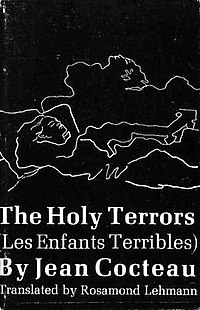Les Enfants Terribles

US edition
|
|
| Author | Jean Cocteau |
|---|---|
| Original title | Les Enfants Terribles |
| Translator | Rosamond Lehmann |
| Illustrator | Jean Cocteau |
| Cover artist | Jean Cocteau |
| Country | France |
| Language | French |
| Publisher | New Directions |
|
Publication date
|
1929 |
|
Published in English
|
1930 |
| Pages | 183 |
| ISBN | |
| OCLC | 86041984 |
Les Enfants Terribles is a 1929 novel by Jean Cocteau, published by Editions Bernard Grasset. It concerns two siblings, Elisabeth and Paul, who isolate themselves from the world as they grow up, an isolation which is shattered by the stresses of their adolescence. It was first translated into English by Samuel Putnam in 1930 and published by Brewer & Warren Inc. A later English translation was made by Rosamond Lehmann in 1955, and published by New Directions () in the U.S., and Mclelland & Stewart in Canada in 1966, with the title translated as The Holy Terrors. The book is illustrated by the author's own drawings.
It was made into a film of the same name, a collaboration between Cocteau and director Jean-Pierre Melville in 1950, and inspired the opera of the same name by Philip Glass. The ballet La Boule de Neige by the choreographer Fabrizio Monteverde with music of Pierluigi Castellano is based on this novel. The story was adapted by the writer Gilbert Adair for his 1988 novel The Holy Innocents, which was the basis for the 2003 film The Dreamers directed by Bernardo Bertolucci.
The story concerns the siblings Paul and Elisabeth who start this story without a father and with a bed-ridden mother, whom Elisabeth looks after. At school Paul is obsessed with the feminine looking Dargelos, while Paul’s school friend Gerard is enthralled by the siblings. However after Paul becomes ill when Dargelos throws a snowball with a stone inside at him, Elisabeth cares for both him and their mother. While nursing Paul it is revealed that the siblings enjoy a relationship characterised by a psychodrama known in the book as " The Game," which can only be played in their shared bedroom, elevated by the Game-play into "The Room." The game devised by Paul and Elisabeth often involves the siblings trying to annoy or irritate each other, by histrionic behaviour on the part of Elisabeth and by a taciturn refusal to be affected by Paul, where the winner is the one that leaves the contest with the last word, a sense of superiority and ideally having caused a display of angry frustration from the other. This game continues after Paul recovers and their mother has died.
...
Wikipedia
